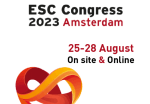Cardiac failure (CF) and sudden cardiac death (SCD) stand out as two of the main causes of death in patients with aortic stenosis. Although transcatheter aortic valve intervention has shown higher survival, these two continue to be the main conditions leading to patient death at followup. In its early days, TAVR also showed benefits, but...
Transcatheter Closure of Patent Foramen Ovale in Thrombophilia Patients
The transcatheter treatment of patent foramen ovale (PFO) has been shown to reduce thromboembolic events in patients with cryptogenic stroke. However, most of large randomized studies have failed to include patients with thrombophilia, either inherited or acquired. For instance, the RESPECT study excluded patients with antiphospholipid antibodies (AFA) or hyperhomocysteinemia, while the REDUCE screened for...
TAVR in Asymptomatic or Minimally Symptomatic Patients: 30-Day Results
Aortic valve replacement (AVR) is recommended for symptomatic aortic stenosis (AS), while close monitoring is the advised strategy for asymptomatic patients, unless they have elevated aortic gradients, reduced ejection fraction, or abnormal stress tests. However, the optimal timing for AVR remains uncertain, especially in light of recent evidence suggesting that AS patients showing signs of...
Coronary Artery Calcium on Non–ECG-Gated Chest CTs: Mere Finding or Therapeutic Opportunity?
CAD related acute phenomena often present as a consequence of poor risk factor monitoring over time. Early detection of these patients, especially high risk patients, has significantly contributed to reducing morbimortality over time. Coronary artery calcification (CAC) is considered a measure of atherosclerosis burden in and might be present in asymptomatic individuals. Most centers do...
ISCHEMIA Trial: Does Complete Anatomical or Functional Revascularization Modify Anything Compared with Medical Treatment?
Chronic coronary syndrome (CCS) has been considered another comorbidity in previous studies, and there has been no significant reduction in cardiovascular mortality or myocardial infarction (MI) rates with revascularization through percutaneous coronary intervention (PCI) or myocardial revascularization surgery (MRS) compared with optimal medical treatment (OMT). One possible reason for the lack of benefit has been...
Is Complete Revascularization Really Necessary after AMI in the Elderly?
The population over 75 is growing gradually, which entails an increase in acute myocardial infarction (AMI) in this group. As we all know, it is fairly common for AMI to present with multivessel disease. It has been shown that younger patients will benefit from complete revascularization vs. a simple resolution of the culprit vessel. However,...
TAVI-in-TAVI with Balloon-Expandable Valves
TAVI (Transcatheter Aortic Valve Implantation) has proven to be beneficial and is currently performed in increasingly younger and lower-risk patients. However, as with surgical bioprostheses, structural deterioration, whether due to stenosis or regurgitation, is one of the challenges we must address. While currently uncommon, this is an issue we will probably see more and more...
What to Do in Cases of AMI with Multivessel Disease
The presence of lesions in multiple vessels is common in ST-segment elevation myocardial infarction (STEMI). It has been shown that, when they are treated in a second procedure, patients have a better outcome. To date, there is limited information available on percutaneous transluminal coronary angioplasty (PTCA) in vessels with severe non-culprit lesions during primary angioplasty....
ESC 2023 | Anticoagulation After Primary PCI in STEMI Patients
The empirical prescription of anticoagulants after percutaneous coronary intervention (PCI), also know as post-procedural anticoagulation (PPA), is nowadays a common practice that uses various types of medications. Despite studies like HORIZONS-AMI and EUROMAX, in which 41% of patients received PPA, and the CCC-ACS registry, where 75% of subjects received PPA after primary PCI, European and...
ESC 2023 | Extended Monotherapy with Clopidogrel vs. DAPT in High-Risk Patients
An increasing number of patients currently present both an elevated ischemic risk and hemorrhagic risk. This means that the selection of the optimal antiplatelet treatment is a clinical challenge. Several studies have shown that P2Y12 monotherapy after minimum dual antiplatelet therapy (DAPT) is a novel strategy to reduce bleeding risk without increasing ischemic risk. Furthermore,...








